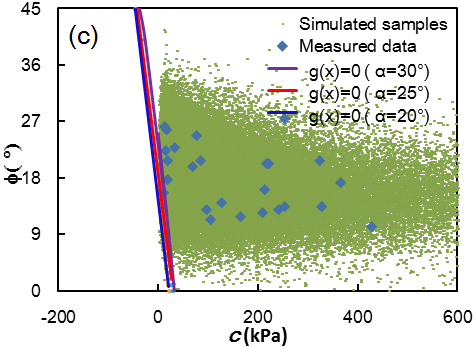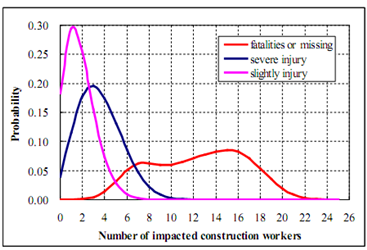Various uncertain factors, involved in the analysis of geotechnical and underground engineering, may lead to the failures of geotechnical and underground structures (e.g., slip of slopes, collapse of tunnels) during their construction and/or operation. To deal with these inevitable risks in geotechnical and underground engineering, the following researches have been conducted for risk assessment and mitigation in geotechnical and underground engineering.
1) A quantitative procedure, which was based upon a large number of lab tests and field tests, was suggested to evaluate the associated uncertainty in soil constitutive models. Thus, the risk involved in the soil constitutive model selection could be fully analyzed and how the decision making was affected by such risk could be investigated. Further, a risk-based criterion was established to aid in selecting soil constitute models in geotechnical and underground engineering.
2) A life-cycle risk management theory, which was based upon the quantitative risk analysis, was advanced in geotechnical and underground engineering. In which, how the geotechnical risks were induced by different factors and environments was revealed, the relationship between the distribution of the consequence loss resulted from the geotechnical risks and the uncertainties in geotechnical parameters and model errors was derived. A national code that based upon the theories of life-cycle risk management and risk level assessment was established. In addition, a risk-based tunnel design method and a tunnel operational performance assessment system were developed.
3) A multi-objective decision making theory was proposed in geotechnical and underground engineering. In which, possible casualties, construction costs, economic losses, and duration losses were simultaneously considered; indeed, the proposed multi-objective decision making theory could be regarded as an effective combination of the mechanical analysis, probability analysis and loss calculations. In other words, a quantitative risk assessment of the project construction was achieved and it could be further incorporated in the engineering decision making process using the proposed multi-objective decision making theory.
The above theories and methodologies have been successfully applied to several major projects in China as demonstrative examples, such as Bohai Bay channel, Shanghai Yangtze river highway tunnel, Zhejiang Qianjiang tunnel, and Qingdao harbor tunnel.
Objective
1) To establish a risk-based criterion that can aid in selecting soil constitute models in geotechnical and underground engineering. 2) To reveal the risk evolution process of geotechnical and underground structures during their life-cycles. 3) To derive the theory of risk assessment and control in geotechnical and underground engineering.
Approach
Multi-objective optimization theory, Bayesian updating theory and quantitative risk analysis method were employed herein to study the risk evolution of geotechnical and underground structures during their life-cycles and corresponding control procedures.
Significant Results and Potential Impact
1) A risk-based criterion for selecting soil constitutive models was established. 2) A life-cycle risk management theory was developed in geotechnical and underground engineering. 3) Some theoretical basis and practical techniques were provided for assessing and controlling the risks in geotechnical and underground engineering.
Principal Investigator
Hongwei Huang, Jie Zhang, and Yadong Xue
Funding
National Natural Science Foundation of China-France cooperation projects (50879058), National 863 Basic Research Program of China (2006AA04Z442), and Yunnan Provincial Science and Technology Department of key projects (2008AD013).
Key Publications
(1) Ministry of Housing and Urban-rural Development of the People's Republic of China. Code of Risk Management for Underground Works of Urban Rail Transit (GB50652-2011), 2011. (In Chinese).
(2) Hongwei HUANG, Risk Management and Its Application in Mountainous Highway Construction. 2nd International Symposium on Geotechnical Safety and Risk, Gifu, Japan, Jun 11-12, 2009. (Keynote)
(3) J.Zhang, H.W.Huang, K.K.Phoon. Application of the Kriging-based response surface method to the system reliability of soil slopes. Journal of geotechnical and geoenvironmental engineering, 2013, 139: 651-655.
(4) H.W. Huang, J. Zhang, L.M. Zhang. Bayesian network for characterizing model uncertainty of liquefaction potential evaluation models. KSCE Journal of Civil Engineering. 2012,16(5):714-722.

Fig. 1. Simulation based method for assessing failure probability

Fig.2. Event tree approach for analyzing casualties

Fig. 3. Vulnerability of workers at a construction site at the presence of hazard



